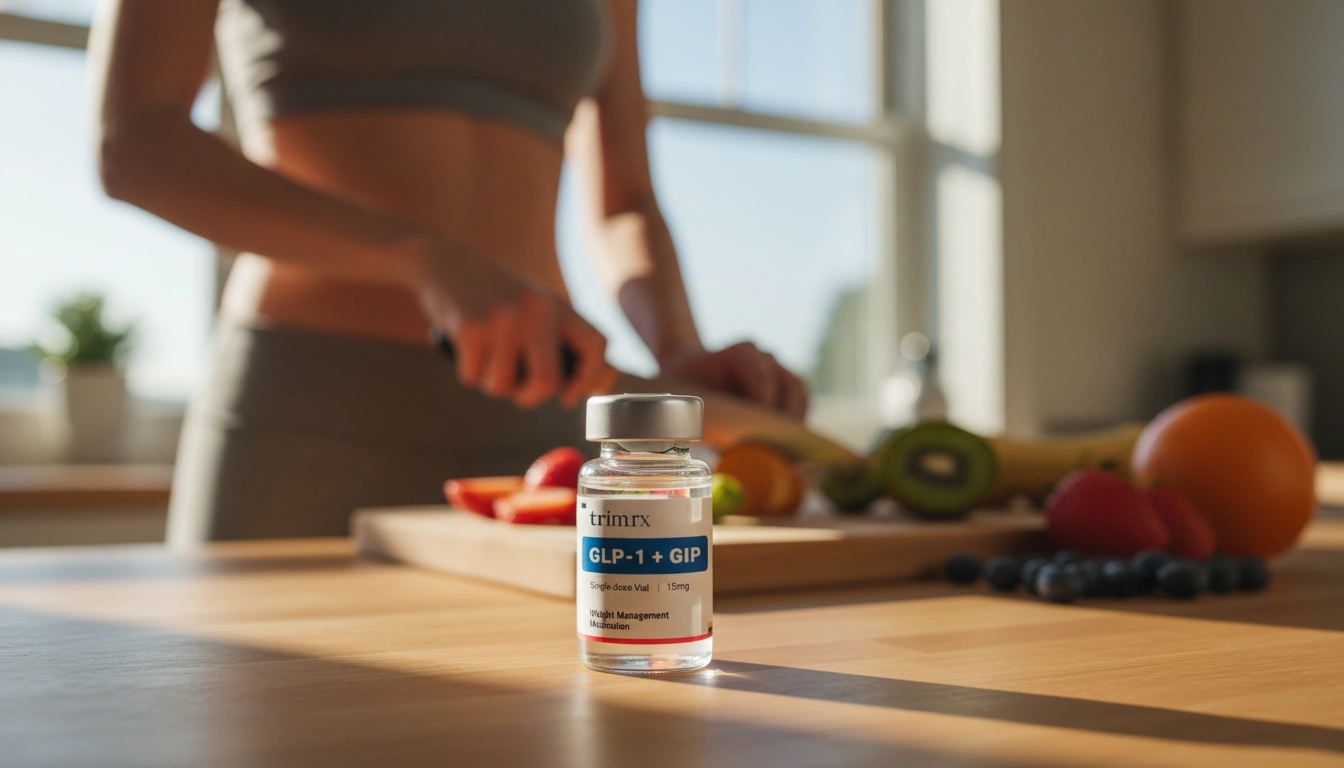How to Reconstitute GLP-1: A Comprehensive Guide to Semaglutide Preparation

Introduction
Did you know that approximately 42% of adults in the United States are classified as obese? This staggering statistic underscores the importance of effective weight management solutions. Among these, medications such as Semaglutide—a glucagon-like peptide-1 (GLP-1) receptor agonist—have emerged as crucial tools in the ongoing battle against obesity and type 2 diabetes. However, the effectiveness of this medication hinges on proper preparation, particularly the reconstitution process.
Understanding how to reconstitute GLP-1 medications like Semaglutide is vital for ensuring their efficacy and safety. This guide will delve deep into the reconstitution process, offering step-by-step instructions, necessary supplies, safety precautions, and storage requirements. Our goal is to equip you with the knowledge needed for successful reconstitution, empowering you on your weight loss journey with TrimRx, where we believe in personalized, medically supervised solutions to help you achieve your health goals.
We’ll cover the following aspects:
- Understanding Semaglutide and its significance
- Preparing for the reconstitution process
- Step-by-step reconstitution instructions
- Dosage and administration guidelines
- Proper storage and stability considerations
- Best practices for reconstitution and troubleshooting
- Clinical considerations and recommendations
By the end of this article, you will have a thorough understanding of how to safely and effectively reconstitute GLP-1 medications, ensuring that you can utilize them to their fullest potential. Let’s embark on this journey together!
Understanding Semaglutide and Its Significance
What is Semaglutide?
Semaglutide is a synthetic GLP-1 receptor agonist, meaning it mimics the action of the naturally occurring hormone GLP-1 in the body. This hormone plays a crucial role in regulating appetite and insulin secretion, making Semaglutide particularly effective for managing blood sugar levels in individuals with type 2 diabetes and aiding in weight loss for those who are overweight or obese.
Medical Uses and Benefits
The primary applications of Semaglutide include:
- Management of Type 2 Diabetes: Semaglutide helps lower blood sugar levels by enhancing insulin secretion and reducing glucagon release, which is particularly beneficial for individuals with type 2 diabetes.
- Weight Loss: Studies have shown that Semaglutide can lead to significant weight loss, making it a valuable option for individuals struggling with obesity. This is achieved through its appetite-suppressing effects, leading to reduced food intake.
Why Reconstitution is Necessary
Many forms of Semaglutide, particularly compounded ones, come as a lyophilized (freeze-dried) powder that requires reconstitution with a suitable diluent before injection. Proper reconstitution not only ensures that the medication is effective but also minimizes the risk of contamination and dosing errors.
Preparing for the Reconstitution Process
Necessary Supplies and Equipment
Before starting the reconstitution process, gather the following supplies:
- Semaglutide vial (lyophilized powder)
- Bacteriostatic water or sterile saline (as specified by your healthcare provider)
- Syringe and needle (typically a 3 mL syringe with a fine needle)
- Alcohol prep pads (for sterilizing surfaces)
- Instruction manual or guidelines from your pharmacy
Ensuring all supplies are on hand before starting will streamline the process and reduce the risk of mistakes or contamination.
Safety Precautions
Safety is paramount when handling and reconstituting medications:
- Work in a clean area: Ensure your work surface is sanitized to prevent contamination.
- Wash your hands thoroughly: Cleanliness is crucial to avoid introducing bacteria into the vial.
- Check expiration dates: Ensure that all your supplies, including the Semaglutide vial and diluent, are within their expiration dates.
Step-by-Step Instructions for Reconstitution
Now that we have the necessary supplies and have taken safety precautions, let’s dive into the detailed reconstitution process.
Step 1: Bringing the Vial to Room Temperature
- Remove the Semaglutide vial from the refrigerator: Allow it to come to room temperature, which typically takes about 10 minutes. This step helps facilitate the mixing process.
Step 2: Cleaning the Vial Tops
- Prepare your alcohol prep pads: Using one pad, clean the rubber top of the Semaglutide vial. This helps eliminate any surface contaminants.
Step 3: Drawing Up the Diluent
- Fill the syringe with bacteriostatic water:
- Remove the cap from the diluent vial.
- Clean the rubber membrane with an alcohol prep pad.
- Draw air into the syringe equivalent to the amount of diluent needed (refer to your specific instructions).
- Insert the needle into the diluent vial and inject the air. This creates a vacuum that makes it easier to draw the liquid.
- Fill the syringe with the appropriate amount of bacteriostatic water (e.g., 1.5 mL for a 3 mg dose, 2.5 mL for a 5 mg dose, or 5 mL for a 10 mg dose).
Step 4: Adding the Diluent to Semaglutide
- Inject the diluent into the Semaglutide vial:
- Insert the needle into the Semaglutide vial and slowly inject the diluent. Aim the stream against the glass wall to minimize bubble formation.
- Allow the diluent to flow down the vial’s wall, avoiding direct contact with the powder.
Step 5: Mixing the Solution
- Gently mix the solution:
- After adding the diluent, gently swirl the vial to mix the contents. Avoid vigorous shaking, as this can degrade the medication.
- Ensure that the powder is completely dissolved and the solution is clear. If you see any particulates or cloudiness, do not use the solution.
Step 6: Storing the Reconstituted Solution
- Store the reconstituted Semaglutide:
- Follow specific storage guidelines. Most often, the reconstituted solution should be stored in the refrigerator at 2-8°C and used within a specified time frame (usually within 28 days).
- Label the vial with the date and time of reconstitution to keep track of its usability.
Dosage and Administration Guidelines
Determining the Right Dosage
The dosage of Semaglutide varies based on individual health needs and should always be prescribed by a healthcare provider. Common starting doses for weight management typically begin at 0.25 mg once weekly, gradually increasing to a maximum of 2.4 mg per week as tolerated.
Administration Techniques
Semaglutide is administered through subcutaneous injection. Here are some key points:
- Injection Sites: Common sites include the abdomen, thigh, and upper arm. Rotate injection sites to minimize irritation.
- Timing: It is typically recommended to administer Semaglutide on the same day each week for consistency.
Proper Storage and Stability Considerations
Key Storage Practices
Proper storage of Semaglutide is essential for maintaining its efficacy. Here are some critical points:
- Refrigeration: The reconstituted solution must be stored in a refrigerator, away from the freezer compartment to prevent freezing.
- Avoid Light Exposure: Keep the vial away from direct light and ensure it is tightly closed when not in use.
Recognizing Signs of Degradation
Be vigilant for any changes in the solution, such as cloudiness, discoloration, or particulate matter. If any of these signs are present, do not use the medication.
Best Practices for Reconstitution and Troubleshooting
Tips for Ensuring Accuracy and Safety
- Double-Check Measurements: Always verify that you are using the correct diluent volume as per your prescription.
- Maintain Sterility: Use sterile tools and work in a clean environment to prevent contamination.
- Consult Healthcare Providers: If you are uncertain about any steps in the reconstitution process, do not hesitate to reach out for guidance.
Common Issues and Troubleshooting
- Cloudy Solution: If the solution appears cloudy after reconstitution, discard it and consult your healthcare provider.
- Incorrect Dosage: If you suspect that you have not measured the diluent correctly, do not use the solution and seek advice on how to proceed.
Clinical Considerations and Recommendations
Monitoring and Follow-Up
Regular follow-ups with your healthcare provider are crucial when using Semaglutide. This includes monitoring blood sugar levels, weight loss progress, and any side effects. Your provider can adjust the dosage based on your response to the medication.
Conclusion
Reconstituting GLP-1 medications like Semaglutide is a precise process that requires attention to detail, proper technique, and adherence to safety precautions. By following the steps outlined in this guide, you can ensure the medication is prepared correctly, maximizing its effectiveness in helping you achieve your health goals.
If you’re interested in exploring personalized weight loss solutions, we invite you to take our free assessment quiz at TrimRx. Together, we can find the right approach for your unique journey.
FAQ
What is Semaglutide used for?
Semaglutide is primarily used for managing type 2 diabetes and aiding in weight loss for individuals who are overweight or obese.
How do I know how much diluent to use for reconstitution?
The amount of diluent needed can vary based on the prescribed dosage. Always refer to your healthcare provider’s instructions for the specific volume.
Can I use Semaglutide if I’m pregnant?
Semaglutide is not recommended for use during pregnancy. Consult your healthcare provider for alternatives.
What should I do if I notice my reconstituted Semaglutide is cloudy?
Do not use a cloudy solution; discard it and consult your healthcare provider for further instructions.
How should I store my reconstituted Semaglutide?
Store the reconstituted Semaglutide in a refrigerator at 2-8°C and use it within the recommended time frame, usually within 28 days.
By following this comprehensive guide, you can confidently reconstitute Semaglutide and integrate it effectively into your weight management plan. Remember, at TrimRx, we are dedicated to providing safe, effective, and personalized weight loss solutions, and we’re here to support you every step of the way!

Transforming Lives, One Step at a Time
Keep reading
China’s Supreme Court Upholds Semaglutide Patent for Novo Nordisk
China’s Supreme People’s Court upholds Novo Nordisk’s semaglutide compound patent, supporting IP protection.
Over 600,000 Californians Risk Losing Access to GLP-1 Weight-Loss Drugs
California’s Medi-Cal will stop covering GLP-1 weight-loss drugs for weight-loss-only prescriptions, effective Jan. 1, 2026.
Weight-Loss Pill Approval Likely to Prompt Overhaul of Packaged Food and Fast-Food Products
FDA approval of GLP-1 weight-loss pills may prompt food makers and restaurants to shift to high-protein, smaller-portion products.



